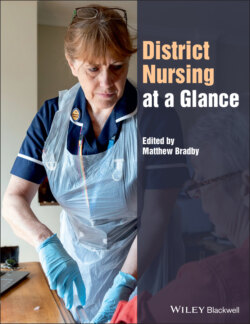Читать книгу District Nursing at a Glance - Matthew Bradby - Страница 22
Оглавление10 Initial assessment and collaborative working
Georgina Newbury, QN and Jayne Foley, QN
Figure 10.1 The multidisciplinary team.
Figure 10.2 A district nurse visits a man living at home with complex healthcare needs.
The multidisciplinary team
The face of traditional community teams has changed over the past 5–10 years to meet the policy agenda of delivering care nearer to the patient’s home. Enabling frail elderly patients and those with complex care needs to remain in their own homes presents challenges. These challenges can only be met by using the combined individual skills of the inter‐professional team in a cohesive manner. How the teams look may differ within the four countries of the UK, but their underlying principles remain the same.
Inter‐professional teams (or multidisciplinary teams) often work best when physically based within the same location, allowing for easier communication and an appreciation of each other’s roles. These teams are made up of doctors, nurses, allied health professionals, social care services and, importantly but sometimes overlooked, the third sector of voluntary services, which can provide extra support and expertise. As with all team working, role dynamics are crucial to success. Traditionally, doctors have often been seen as the leaders of inter‐professional teams; however, within the community, district nurses are increasingly taking the leadership role as the key coordinators of care. They will be the first health professional within the team to meet with the patient with initial referrals coming from GPs, families and carers or other district nursing teams. Their responsibility is then to ensure that the right team members are informed of the patient’s needs and involved in planning their care in the most efficient, safe and appropriate manner.
Assessment and referral
Patients with complex and enduring health problems are increasing in number and the degree of frailty within the ageing population is apparent to all health professionals. District nurses may well have the required advanced assessment skills, but the size of general caseloads makes managing the complexities of inter‐professional referrals time‐consuming and this runs the risk of being uncoordinated. District nurses must have a strong understanding of their local population’s health needs, including people who may be socially marginalised.
Inter‐professional working is very rewarding for professionals working within these teams. They are a cohesive working group with clear goals for excellent patient care. Nurses work particularly well within such teams; however the skills required are at an advanced level. Nurses who are involved in the complex assessment process will have undertaken further education, often holding a recognised specialist practice qualification. A true understanding of community care provision is imperative and a working knowledge of how ongoing services are provided helps with complex decision‐making. Nurses without this knowledge may well possess excellent assessment skills, but may be more reliant on the input of secondary care.
Referrals to allied health professionals, including occupational therapists, physiotherapists, or speech and language therapists, will ensure that the patient’s ability to remain safely within their own home is considered from every angle (Figure 10.1). The medical registrar or consultant provides the necessary specialist intervention and social care can be organised to provide vital support with daily living. These packages are often provided as a short‐term intervention, giving the social worker time to assess and organise an ongoing package of care. This integrated approach has proven vital in managing patients discharged to the community after an admission for Covid‐19.
Patients are often initially referred to district nursing services when they are at risk of falling at home. The nurse needs to be able to undertake a holistic assessment using a range of assessment tools. The key elements of an assessment in this situation will involve the nurse carrying out a full physical, psychological, social and environmental assessment. Their role then is to assess, plan and implement care in a personalised manner. Computer systems are crucial to the success of high‐quality care delivery and these continue to develop, with better communication referral packages being introduced into the health system. Access to a patient’s past medical history and prescription drugs is imperative within the initial assessment phase. Timely care can only be provided when information can be shared instantly.
Nurses undertaking highly specialist initial assessment roles can subsequently miss the opportunity to ‘nurse’, as once the intense period of the assessment is over, any ongoing nursing care will be referred on to the district nursing team within the locality. However, other professionals such as the physiotherapist and occupational therapist may well have ongoing interaction with the patient, developing longer therapeutic relationships (Figure 10.2).
The third sector and carers
Working with the third sector has added to the diversity and richness of services, with befriending schemes – Age UK and the British Red Cross for example – being crucial within a true inter‐professional team. They can provide the small but important services that may fall outside the remit of either health or social services. They are also able to support carers, who themselves may be elderly and may, possibly, have previously been reliant on the person who has now become the patient. Carers, as is increasingly well understood, are the vital backbone of personal social care within the UK; however, many of them are still not recognised for the important role they provide within the community.
Good inter‐professional working can assist in meeting NHS targets, but it also keeps patients in their own homes for longer, with ongoing care being passed back to their GP and local district nursing team after a crisis has been averted.
